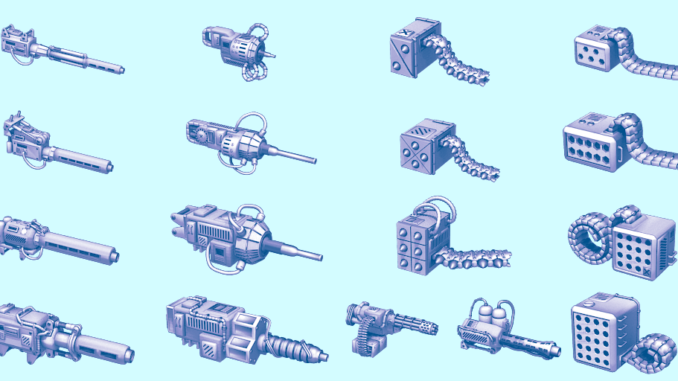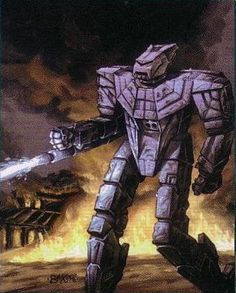
Welcome to the HPG Newsburst – Inordinate Ordinance
In Part 1 we examined the various weight classes in Battletech. Today we look into the components that make up a ‘mech. This will give you all the knowledge needed to assess a 3025 era battlemech based on its Technical Readout (TRO) or SARNA Wiki page.
When you inflict internal damage to a location (damage to the internal structure of a ‘mech, not the armor plating) you can score a critical hit on any components located there. Any component can be destroyed, from hand actuators to ammunition bins full of missiles.
Critical Systems
A ‘mech has many important components that impact its design and operation. The three that I want to focus on are the cockpit, the engine and the gyro. Why these three? Because if any one of these takes damage, things get dicey for the unfortunate mechwarrior. Each is located either in the head or center-torso of a battlemech. In Battletech if you ever lose your head or center-torso, the ‘mech is destroyed.
First, the cockpit. Whenever the head as a whole takes damage the mechwarrior will consider retreating, as the head is not meant to withstand continual punishment. If the cockpit takes a critical hit, whoever ends up claiming the battlefield wins a multi-million C-bill battlemech, in a slightly used condition.
Next, a ‘mech’s fusion engine. Located in the center-torso the engine can take 3 hits before well… exploding. Each hit significantly increases the heat a ‘mech generates, forcing the mechwarrior to do things with incredible inefficiency. Side effects may include broiling the mechwarrior, cooking off the ammo or battlemech shutting itself down to cool off. Hostiles can in fact hit the broad, stationary side of a barn.
Finally, the gyroscope. One Hundred ton bipedal robots with massive weapons and jump jets need a gyro to stay upright. The gyro is mounted in the center-torso, and can take 2 hits before no longer being gyroscopic. The first hit makes maneuvering and staying upright difficult for the mechwarrior. The second hit rewards the marksman with an opponent who is now little more than a glorified turret. Without a gyro ‘mechs cannot move or stand and are reduced to slowly turning on the spot.
Big Guns Never Tire
In 3025 there are 3 main categories of weapon: autocannons, energy weapons and missiles. Each has its own advantages and the factions of the Inner Sphere have opinions or logistical reasons to favor some weapons over others. For instance, the Free Worlds League has a limited supply of PPCs in this era, so it is common to see them swapped out for large lasers instead.
Autocannons
Autocannons are heavy, but have impressive heat to damage ratios and come in a range of calibers. The shorthand format for an autocannon is AC/X, where X represents the caliber. The available calibers are 2, 5, 10 and 20, with the caliber representing the damage inflicted by a successful hit. As we increase in damage, we increase in the heat cost to shoot, while also decreasing the effective range.
An AC/2 may be a weak weapon but it will be the longest range weapon we talk about today. It does practically no damage and is mostly used for sniping helicopters. Due to the weight of the weapon and the risk of hauling ammo, they are often found on fire-support ‘mechs designed to serve a dedicated anti-aircraft role. On the opposite end of the scale is the AC/20. This autocannon forces you to get in close to punt a shell that does 20 damage to a single location. It is a can-opener for battlemechs and will make even the heaviest ‘mech hesitate when approaching the wielder.
The AC/5 and AC/10 are suited to mid-range engagements. Accurate at range, they are flexible and provide reliable damage output for minimal heat. However, the AC/5 weighs 8 tons, while the AC/10 is 12 tons, before including ammunition. These things are heavy and ‘mechs equipped with autocannons often have to make sacrifices elsewhere.
Energy Weapons
Mechwarriors love energy weapons because they don’t need ammunition, so cannot explode. They are light in tonnage and have decent damage output, but at a high heat cost. There are two types of energy weapon in 3025: the laser and the PPC.
Lasers come in three sizes: small, medium and large. Small lasers are short range, low damage, low heat weapons and are really more of a backup weapon. The CGR-1A1 Charger has 5 of these as its loadout; underwhelming for an assault ‘mech. Only 2.5 tons of its 80 ton bulk is used on weaponry. Don’t be like the Charger.
Medium lasers are middle of the road in every respect and very common in Battletech, due to its balanced and versatile design. 5 damage for 3 heat is not bad; especially considering it weighs only a ton. You will see medium lasers on pretty much every mech. On heavier battlemechs you can see arrays of medium lasers as secondary weapons, for example the stock CPLT-C1 Catapult has four medium lasers backing up a pair of LRM/15 pods.
Large lasers have significant heat draw but solid damage and range. This makes for a tempting addition to any medium or heavy battlemech. Not matching the AC/10 in damage while generating almost 3 times the heat, the large laser makes itself competitive by only weighing 5 tons. This makes it more accessible as any tonnage saving translates to more heat sinks, armor or weaponry. The medium laser is far more efficient than the large laser in terms of heat to damage, but the large laser has greater range and puts 8 damage onto a single location instead of 5.
The PPC, or particle projector cannon, is a magnetic accelerator weapon. PPCs are unique among energy weapons as they have a minimum range due to the field inhibitor that prevents electrical failure from firing the PPC at full power while at point blank range. In terms of characteristics, the PPC is the hottest weapon we will look at today, dealing 10 damage per hit and with the same range characteristics as an AC/5. PPCs are usually seen on larger ‘mechs like the 80 ton Awesome. As always, a ‘mech exists that is preventing me making broad and definitive statements. The PNT-9R Panther, a 35 ton PPC ‘mech is our subversive battlemech of the day.

Missiles
Missiles come in two variants: long range missiles (LRM/X) and short range missiles (SRM/X). Where the numeric rating of an autocannon represents caliber, for missile weapons it dictates the number of missiles in a salvo. After you hit with a missile weapon you roll on the cluster chart to determine how many of the shots from your volley hit the target.
LRMs are long reaching weapons with a minimum range. They can fire indirectly with help from a spotter and come in 5, 10, 15 and 20 packs. Each missile does one damage and after rolling for clusters you divide the damage into groups of 5 damage, which can hit different areas of a ‘mech. The drawback of LRMs is the high quantity required to get beyond lightly sanding a target. While an AC/20 can deal 20 damage to one location, the LRM 20 is probably going to deal 12 or so damage in clusters of 5, 5 and 2 to various locations of the target. The advantage of this is the heightened ability to seek critical hits on exposed locations; from a safer distance than SRMs.
SRMs come in 2, 4 and 6 packs. They share range characteristics with medium lasers and the AC/20, and do 2 damage per projectile. Unlike the LRMs they do not group this damage into larger clusters, which makes them superior crit-seekers. They are also very light and, due to their smaller salvos, you probably don’t need to bring as much ammo. The drawback is that you still have to carry ammo into short range engagements. Unlike the AC/20 you are not going to be blowing holes in the opponent, just sandblasting them a bit. That is until you factor in tonnage. You could bring four SRM/6s and enough ammo for 45 salvos (that is 11 turns of SRM mayhem) for the same tonnage as one AC/20 and 5 rounds. That is 32 damage on average, assuming you hit with it all. There are significant heat concerns, but in my experience any mechwarrior that relies upon SRMs as a primary weapon is almost certainly on a one-way trip.
The Little Guys
There are two more weapons that I want to talk about and both function as backup weapons: flamethrowers and machine guns. The small laser also falls into this category as all three weapons have low damage, heat, tonnage and range so are usually an afterthought. Unless you play games with infantry, where you will find them invaluable. Flamethrowers can set the ground on fire and generate some heat on opposing ‘mechs (if you play with that rule) while the MG can auto-fire (again, if you play with that rule). The MG carries ammo, while the flamethrower does not as it uses heat from the fusion reactor of the ‘mech. Don’t discount these weapons though, as each hit on an opposing ‘mech does damage and each internal hit could score a debilitating critical hit, regardless of whether the weapon was a MG or an AC/20.
That is it! Thank you so much for reading this series of glossary articles. If you have any questions please leave a comment and I will get back to you as I may well have missed something in my efforts to get these two articles below 3,ooo words! Now we can explore what Battletech has to offer from both a lore and tabletop perspective. School is out and I hope to catch you next time, when we dive into some of the battlemechs in the current beginner boxes.
